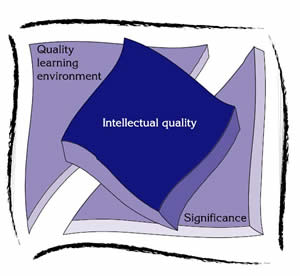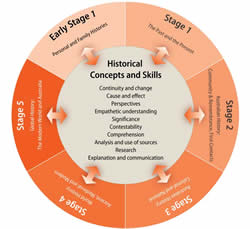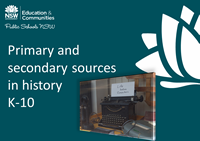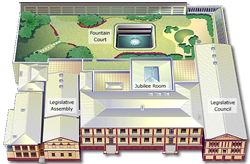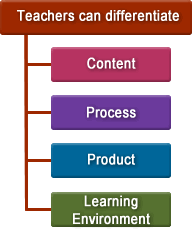Programming
Components of programming
When programming for history, it is important to consider all elements unique to the discipline. In this part of the course, we unpack the syllabus components in order for you to upload a unit of learning, the course deliverable, onto Program Builder by the completion of this course.
Teaching programs are the product of collaborative planning and programming and they provide a record of implemented curriculum that is to be retained by the school. Teaching programs are also flexible working documents that evolve over time and include; a scope and sequence, unit and lesson plans, resources, assessment schedules, reporting plans, program registers and evaluations.
|
|
Quality Teaching in historyWhen programming the specific components for history, teachers will incorporate aspects of the Quality Teaching model and address the three dimensions of: Intellectual quality, Quality learning environment and Significance. Questions to consider:
|
What is historical inquiry?
|
Historical inquiry occurs when:
|
|
Key inquiry questions provide a framework to develop student’s historical knowledge, understanding and skills. In the primary syllabus these questions are found beneath the individual topics, however, in the secondary syllabus, they are at the beginning of each time period.
The questions:
-
support primary teachers to scaffold learning about history
-
support secondary students to adopt inquiry based learning in order to investigate significant events and people
-
are used to frame the topics and to give direction to programming and teaching and learning
-
provide a platform for learners to interact with higher-order questioning opportunities
|
|
Engage with the Historical Inquiry PowerPoint (.ppt 5MB) and discuss with your colleagues how the historical inquiry process is closely linked to the teaching of historical skills. |
|
|
Reflect on how you will embed the historical inquiry process into your final course deliverable. |
Concepts and skills are embedded in the knowledge, understanding and skills history syllabus outcomes. Historical concepts and skills are organised in stages and are mapped as learning continuums. The continuums should be used in the programming process to determine the concepts and skills students have already developed to ensure informed teaching is taking place.
|
Click image for more information. |
|
What are sources?
|
Click the image to view the Primary and secondary sources in history PowerPoint |
Many issues may arise when using sources, often around context and reliability. Historians analyse sources to discover possible evidence that is relevant to their particular historical inquiry. They ask probing questions to obtain evidence from various sources. Therefore, sources are not the same as evidence. A source becomes evidence if it is used to answer or refute a question on the past. It may be evidence for one aspect of history but not for another. Some sources contain aspects of useful information, but often not all of the evidence is needed for the inquiry process. Sources cannot be taught in isolation, but rather should be used to enhance the exploration of the key inquiry questions within the context of the unit of learning.
|
Benefits of a site study
|
Click the image of NSW Government House for more details |
A site study is used to support the understanding of current learning and to expose students to learning experiences outside the classroom. It is an inquiry based examination of a historically or culturally significant site. Site studies assist in the development of students’ understandings, skills and attitudes. They also provide opportunities to learn from the wider community, to build upon and reinforce the school curriculum. Suggested places for site studies:
When integrating a site study into a unit of learning consider the following:
Where it is not practical for your class to physically travel to a site, you may wish to consider a virtual tour. There are many freely available on the internet; others will charge a fee for the use of their site. Consider the following guidelines:
For more details concerning excursions go to the NSW Department of Education and Communities policy.
|
Differentiation
|
Effective curriculum planning and programming requires teachers to differentiate learning for history in response to students’ cultural backgrounds, learning profiles, interests and needs. Differentiation relates to understanding individual differences and devising teaching strategies to challenge and support every student’s learning. In teaching history the additional considerations need to be given to the cultural background and heritage of students and how this impacts on the focus that may need to be taken. The historical concepts and skills continuums provide a scaffold for teachers to differentiate history K–10 for each stage of learning. |
|
|
Content |
The content is described in the history syllabus for each stage and includes the key concepts and skills. The resources and support materials which represent the syllabus content, chosen by the teacher, provide access for all student learning needs. |
|
Process |
The process of learning is how students make sense of the knowledge, understanding and skills of history. Student learning can be differentiated by providing varied options at increasing or decreasing difficulty based on the syllabus content. |
|
Product |
Learning products are student work, in a variety of modes, which reflect individual learning responses within a developed, shared understanding of explicit quality criteria. The products demonstrate what students know, understand and are able to do as a result of their explicit learning in history. |
|
Learning environment |
Provide a supportive learning environment with opportunities for student self-regulation through scaffolding. Reference prior learning and monitor student progress of appropriately challenging work to support educational risk-taking. Promote student engagement and ownership of their learning with clear expectations of student achievement for success. |
Tomlinson, C.A. and Allan, S.D. (2000) infer the following definition of differentiated programming in Leadership for differentiating schools and classrooms.
-
having high expectations for all students
-
permitting students to demonstrate mastery of material they already know and to progress at their own pace through new material
-
providing different avenues for acquiring content, to process or make sense of ideas, and to develop products
-
providing multiple assignments within each unit, tailored for students with differing levels of achievement
-
allowing students to choose, with the teacher’s guidance, ways to learn and how to demonstrate what they have learned
-
flexible (teachers move students in and out of groups, based on students’ instructional needs).
-
a different lesson plan for each student each day
-
assigning more work at the same level to high-achieving students
-
all the time (often it is important for students to work as a whole class)
-
using only the differences in student responses to the same class assignment to provide differentiation
-
giving a normal assignment to most students and a different one to advanced learners
-
limited to subject acceleration (teachers are encouraged to use a variety of strategies).
Watch the video Differentiation: Proactive instruction. Reflect or discuss the implications of Carol Tomlinson’s lecture (3:47mins).
There are many different teaching strategies or theories which can be referenced to support a diverse range of learners when teaching history.
Some of these are:
-
8 Aboriginal Ways of Learning
-
De Bono’s 6 Thinking Hats
-
Bloom’s Taxonomy
-
Gardner’s Multiple Intelligence Theory
-
Anderson/ Krathwohl Taxonomy
-
Williams model
-
Maker model
-
Kaplan model
-
Graphic organisers
-
Scaffolding reading
-
Learning profile development through 4MAT
-
Web Quests.
|
|
With reference to your chosen topic, think about possible teaching and learning strategies to cater for diverse learners. Record your ideas using the Learner diversity scaffold (.pdf 140kB) provided in the Activity booklet. |
Learning across the curriculum (LAC)
Learning across the curriculum content is a common feature of all new Board of Studies NSW syllabuses. It is important when programming that you consider the history specific learning across the curriculum content.
The learning across the curriculum content is automatically included in the syllabus content descriptions for history and identified by the relevant icon.
When programming, careful consideration must be given to using a balanced and logical approach when addressing the content descriptions, the Learning across the curriculum content and the teaching and learning activities.
|
|
Refer to the Learning across the curriculum section of the history syllabus. |
|
|
With reference to your chosen topic, select a content description with a variety of learning across the curriculum content icons. Brainstorm teaching and learning activities using the example and Learning across the curriculum scaffold (.pdf 142kB) provided in the Activity booklet. |
Assessment
Assessment involves the collection and evaluation of evidence of a student’s learning. It is integral to teaching and learning and has multiple purposes. Assessment can enhance student engagement and motivation, particularly when it incorporates interaction with teachers, other students and a range of sources.
As part of the programming process, teachers provide a range of appropriate assessment strategies, through which students can demonstrate achievement of the outcomes.
|
Assessment for learning |
Assessment as learning |
Assessment of learning |
|
|
|
|
|
Read information about Assessment for, as and of learning and Advice on Assessment at the Board of Studies NSW website. |
|
|
Download the step-by-step guide to developing assessments (.pdf 301KB) and keep for future reference. |
|
|
With reference to your chosen topic, think about possible assessment strategies to use when teaching. Use the examples of assessment strategies in the Activity booklet and record your responses in the Assessment scaffold (.pdf 111kB). |
Presenter notes
Indicative time: 120 minutes
This tab provides participants with an opportunity to evaluate:
-
their knowledge of the programming components for history
-
their current programming practices for history in order to design a unit of learning.
In particular, participants will:
-
revisit Quality Teaching principles
-
discuss how the historical inquiry process is embedded into the teaching of skills by evaluating a unit of learning
-
view practical ideas of how to teach historical concepts and skills
-
reflect on the use of sources to achieve historical concepts and skills
-
determine the difference between primary and secondary sources and consider the effectiveness of quality sources
-
deepen knowledge about the benefits of historical sites both actually and virtually, to enhance outcomes, skills and concepts
-
discuss strategies to cater for diverse learners
-
explore the learning across the continuum content specifically for history
-
revise a range of assessment strategies.
Provide time for participants to complete the activities in each of the tabs of the Programming section of the course. Participants may prefer to work in pairs for these activities.
For larger groups, the task of creating a unit of learning could be discussed and ideas established as a whole. However, the unit of learning designed using Program Builder in Tab 4 is an individual delivery component.
-
Discuss the relevance and importance of having a Quality Teaching focus when programming.
-
Explore the interactive diagram about historical inquiry and discuss the centrality of key inquiry questions in the process.
-
After downloading the Historical Inquiry PowerPoint, lead a discussion about how the historical inquiry process is closely linked to the teaching of historical skills.
-
Download the concepts continuum and skills continuum from the Board of Studies NSW and note the progression in learning and usefulness for gauging prior knowledge of students.
-
Think about how to effectively use concepts and skills in the unit of learning. Record responses in the Activity booklet.
-
Engage with the Primary and secondary sources in history PowerPoint. Discuss how sources are most effective when taught in context.
-
Identify a range of appropriate primary and secondary sources for use in your unit of learning. Think of appropriate teaching and learning strategies to introduce these sources and justify how this would enhance student capacity in history.
-
Examine the information about site studies in history. Consider appropriate site studies for your chosen topic and think about teaching and learning before, during and after the visit. Responses should be recorded in the Activity booklet.
-
Use the interactive diagram showing how teachers can cater for diverse learners. After downloading the following resources, discuss strategies to enhance differentiation in your unit of learning:
-
Carol Tomlinson’s lecture on differentiation
-
ACARA’s documents for specific differentiation
-
Curriculum support documents.
-
-
Identify the diverse needs of learners in your class/year group. Generate a range of modifications that could be made to the content, process, product or learning environment when teaching your chosen topic that suits the needs of these students and record your responses in the Activity booklet.
-
Download learning across the curriculum content from the syllabus and analyse how it aligns with knowledge, concepts and skills.
-
Examine the range of ideas provided relating to the teaching and learning across the curriculum content in the Stage 3 example. Detect the learning across the curriculum content evident in your chosen topic and brainstorm how to incorporate these into your unit of learning.
-
Access the NSW BOS assessment documents and download the step-by-step guide to developing assessments. These should be kept for future reference.
-
Using your knowledge about assessment for, as and of learning, think about appropriate assessment strategies that could be incorporated into your unit of learning. Record responses in the Activity booklet.

